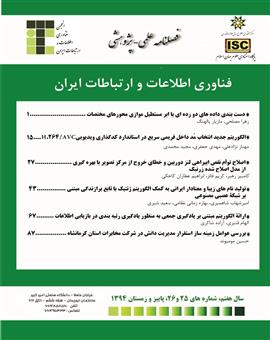اصلاح توام نقص ابیراهی لنز دوربین و خطای خروج از مرکز تصویر با بهرهگیری از مدل اصلاح شده زرنیک
محورهای موضوعی : عمومى
کلید واژه: تابع ابیراهی فاز, خطای خروج از مرکز تصویر, چندجملهای زرنیک, چندجملهای چبیشف, آنالیز چندطیفی,
چکیده مقاله :
کاهش کیفیت تصویر در یک سامانه اپتیکی تابع پارامترهای متفاوتی میتواند باشد. برخی از این پارامترها عبارتند از: ابیراهی لنز، خطای رقمیسازی و خطای مونتاژ سامانه. در حوزه خطای مونتاژ معمولا دو نوع خطای کلی در نظر گرفته میشود: 1) عدم متعامد بودن پرده تصویر و محور اپتیکی که اغلب در قالب خطای prism از آن نام برده میشود.2) خطای عدم عبور محور اپتیکی لنز از مرکز تصویر که تحت عنوان خطای خروج از مرکز تصویر (de-centering) از آن یاد میشود. از این میان مقاله حاضر قصد دارد تا به مطالعه ابیراهی لنز پرداخته و نقص ابیراهی آن را تواما با خطای خروج از مرکز اصلاح و جبران کند. برای این منظور ابیراهیهای زایدل در قالب مومنتهای اصلاح شده زرنیک مبتنی بر چندجملهای چبیشف نوع دوم به صورت توابع مجزا روی فضای کارتزین بازنویسی میگردند. سپس مومنتهای بازنویسی شده به گونهای اصلاح میگردند که با در نظر گرفتن خطای خروج از مرکز، تابع ابیراهی فاز را نیز مدل کنند. نهایتا ضرایب مدل معرفی شده جهت تخمین در دو کلاس متقارن و نامتقارن دستهبندی میشوند. سپس این ضرایب با بهرهگیری از آنالیز چندطیفی تخمین زده میشوند. جهت تخمین ضرایب جملات متقارن از آنالیز tri-coherence و برای ضرایب جملات نامتقارن از آنالیز bi-coherence استفاده شده است. نتایج آزمایشگاهی دقت و بازدهی راهکار پیشنهادی را تایید میکنند.
The reduction of image quality in an optical system can depend on different parameters. Some of these parameters are: lens aberration, digitization error and system assembly error. In the field of assembly error, two types of general errors are usually considered: 1) the non-orthogonality of the image curtain and the optical axis, which is often referred to as the prism error. 2) the error of the optical axis of the lens not passing through the center of the image, which is called It is called de-centering error. Among these, the current article aims to study lens aberration and correct and compensate for its aberration along with eccentricity error. For this purpose, the Seidel misdirections are rewritten in the form of modified Zernike moments based on the second type Chebyshev polynomials as separate functions on the Cartesian space. Then, the rewritten moments are modified in such a way that they also model the phase deviation function by considering the eccentricity error. Finally, the coefficients of the introduced model are classified into two classes, symmetric and asymmetric. Then these coefficients are estimated using multispectral analysis. Tri-coherence analysis was used to estimate the coefficients of symmetrical sentences, and bi-coherence analysis was used for the coefficients of asymmetric sentences. The laboratory results confirm the accuracy and efficiency of the proposed solution.
.V. Orekhov and B. Abidi, “Universal camera calibration with automatic distortion model selection,” in Image Processing, 2007.ICIP 2007.IEEE International Conference on, 2007, p. VI - 397 - VI - 400.
2.R. G. V. Gioi, “Towards high-precision lens distortion correction,” in Image Processing (ICIP), 2010 17th IEEE International Conference on, 2010, pp. 4237 - 4240.
3.C. Y. Vincent, “Multiview camera-calibration framework for nonparametric distortions removal,” Robotics, IEEE Transactions on, vol. 21, no. 5, pp. 1004 - 1009, 2005.
4.C. Lin, S. Chang, and Y. Lay, “Automatic distortion measuring system with reticle positioning for enhanced accuracy,” Measurement, 2008.
5.M. Ahmed, “Nonmetric calibration of camera lens distortion: differential methods and robust estimation,” Image Processing, IEEE Transactions on, vol. 14, no. 8, pp. 1215 - 1230, 2005.
6.R. Hartley and S. B. Kang, “Parameter-free radial distortion correction with center of distortion estimation,” Pattern Analysis
and Machine Intelligence, IEEE Transactions on, vol. 29, no. 8, pp. 1309-1321, 2007.
7.S. Aritan, “Efficiency of non-linear lens distortion models in biomechanical analysis of human movement,” Measurement, vol. 43, no. 6, pp. 739-746, 2010.
8.V. Mahajan, Optical imaging and aberrations. SPIE Press, 1998.
9.C. Ricolfe-Viala and Antonio-José Sánchez-Salmerón, “Correcting non-linear lens distortion in cameras without using a model,” Optics & Laser Technology, vol. 42, no. 4, pp. 628–639, 2010.
10.B. Tordoff and D. W. Murray, “The impact of radial distortion on the self-calibration of rotating cameras,” Computer Vision and Image Understanding, vol. 96, no. 1, pp. 17–34, 2004.
11.J.-P. Tardif, P. Sturm, M. Trudeau, and S. Roy, “Calibration of Cameras with Radially Symmetric Distortion,” IEEE TRANSACTIONS ON PATTERN ANALYSIS …, vol. 31, no. 9, pp. 1552 - 1566, 2009.
12.J. Lin, M. Xing, D. Sha, D. Su, and T. Shen, “Distortion measurement of CCD imaging system with short focal length and large-field objective,” Optics and Lasers in Engineering, vol. 43, no. 10, pp. 1137-1144, Oct. 2005.
13.F. Devernay and O. Faugeras, “Straight lines have to be straight,” Machine Vision and Applications, vol. 13, no. 1, pp. 14-24, Aug. 2001.
14.C. Hughes, R. McFeely, P. Denny, M. Glavin, and E. Jones, “Equidistant fish-eye perspective with application in distortion centre estimation,” Image and Vision Computing, vol. 28, no. 3, pp. 538-551, Mar. 2010.
15.H. Farid and A. C. Popescu, “Blind removal of lens distortion,” JOSA A, vol. 18, no. 9, pp. 2072-2078, 2001.
16.W. Yu, “Image-based lens geometric distortion correction using minimization of average bicoherence index,” Pattern Recognition, vol. 37, no. 6, pp. 1175-1187, 2004.
17.رهبر، کامبیز؛ فائز، کریم؛ اصلاح نقص ابیراهی لنز دوربین با بهره گیری از مومنت های زرنیک، فصلنامه فناوری اطلاعات و ارتباطات ایران، سال دوم، شماره های 5 و6، پاییز و زمستان 1389.
18.C. J. R. Sheppard, S. Campbell, and M. D. Hirschhorn, “Zernike expansion of separable functions of Cartesian coordinates” Applied optics, vol. 43, no. 20, pp. 3963-6, Jul. 2004.
19.J. Fackrell and S. McLaughlin, “Non-linearity detection for condition monitoring using higher order statistics,” Proc. COMADEM’96, 1996.

